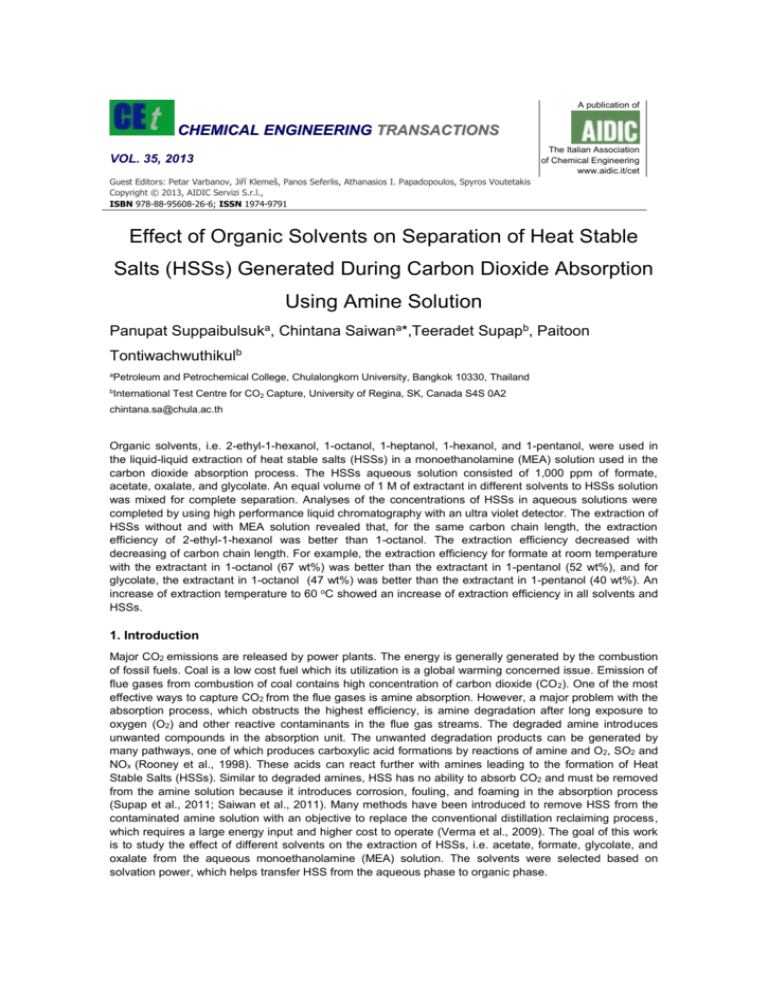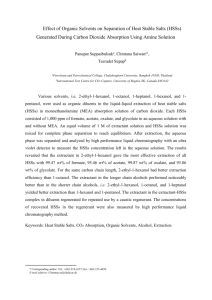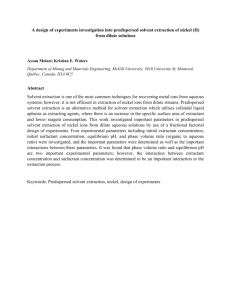Format And Type Fonts
advertisement

A publication of CHEMICAL ENGINEERING TRANSACTIONS The Italian Association of Chemical Engineering www.aidic.it/cet VOL. 35, 2013 Guest Editors: Petar Varbanov, Jiří Klemeš, Panos Seferlis, Athanasios I. Papadopoulos, Spyros Voutetakis Copyright © 2013, AIDIC Servizi S.r.l., ISBN 978-88-95608-26-6; ISSN 1974-9791 Effect of Organic Solvents on Separation of Heat Stable Salts (HSSs) Generated During Carbon Dioxide Absorption Using Amine Solution Panupat Suppaibulsuka, Chintana Saiwana*,Teeradet Supapb, Paitoon Tontiwachwuthikulb a Petroleum and Petrochemical College, Chulalongkorn University, Bangkok 10330, Thailand b International Test Centre for CO2 Capture, University of Regina, SK, Canada S4S 0A2 chintana.sa@chula.ac.th Organic solvents, i.e. 2-ethyl-1-hexanol, 1-octanol, 1-heptanol, 1-hexanol, and 1-pentanol, were used in the liquid-liquid extraction of heat stable salts (HSSs) in a monoethanolamine (MEA) solution used in the carbon dioxide absorption process. The HSSs aqueous solution consisted of 1,000 ppm of formate, acetate, oxalate, and glycolate. An equal volume of 1 M of extractant in different solvents to HSSs solution was mixed for complete separation. Analyses of the concentrations of HSSs in aqueous solutions were completed by using high performance liquid chromatography with an ultra violet detector. The extraction of HSSs without and with MEA solution revealed that, for the same carbon chain length, the extraction efficiency of 2-ethyl-1-hexanol was better than 1-octanol. The extraction efficiency decreased with decreasing of carbon chain length. For example, the extraction efficiency for formate at room temperature with the extractant in 1-octanol (67 wt%) was better than the extractant in 1-pentanol (52 wt%), and for glycolate, the extractant in 1-octanol (47 wt%) was better than the extractant in 1-pentanol (40 wt%). An increase of extraction temperature to 60 oC showed an increase of extraction efficiency in all solvents and HSSs. 1. Introduction Major CO2 emissions are released by power plants. The energy is generally generated by the combustion of fossil fuels. Coal is a low cost fuel which its utilization is a global warming concerned issue. Emission of flue gases from combustion of coal contains high concentration of carbon dioxide (CO 2). One of the most effective ways to capture CO2 from the flue gases is amine absorption. However, a major problem with the absorption process, which obstructs the highest efficiency, is amine degradation after long exposure to oxygen (O2) and other reactive contaminants in the flue gas streams. The degraded amine introduces unwanted compounds in the absorption unit. The unwanted degradation products can be generated by many pathways, one of which produces carboxylic acid formations by reactions of amine and O2, SO2 and NOx (Rooney et al., 1998). These acids can react further with amines leading to the formation of Heat Stable Salts (HSSs). Similar to degraded amines, HSS has no ability to absorb CO2 and must be removed from the amine solution because it introduces corrosion, fouling, and foaming in the absorption process (Supap et al., 2011; Saiwan et al., 2011). Many methods have been introduced to remove HSS from the contaminated amine solution with an objective to replace the conventional distillation reclaiming process, which requires a large energy input and higher cost to operate (Verma et al., 2009). The goal of this work is to study the effect of different solvents on the extraction of HSSs, i.e. acetate, formate, glycolate, and oxalate from the aqueous monoethanolamine (MEA) solution. The solvents were selected based on solvation power, which helps transfer HSS from the aqueous phase to organic phase. 2. Experimental 2.1 Material and equipment Extractant A (Sigma-Aldrich) in chloride form was used for preparing extractant B (extractant A in hydroxide form). Sodium hydroxide (p.a. grade, Merck) was required to react extractant A to obtain the extractant B. Silver nitrate (analytical grade, Merck), sodium chromate (anhydrous, extra pure, Riedel-de Haen) and ethanol (99.99 %, RCI Labscan, Thailand) were used in a titration of chloride ions remaining in extractant B after the conversion. Formic acid (85 %, Carlo Erba), acetic acid (99.7 %, RCI Labscan, Thailand), sodium glycolate (analytical grade, Tokyo Chemical Industry), and sodium oxalate (Puro grade, Carlo Erba) were used as heat stable salts (HSSs). Monoethanolamine (MEA) (99.5 %, Merck) was mixed with HSS to simulate the industrial condition of degraded MEA solution. Solvents used in this study were 1-octanol (≥99.5 %, Fluka), 2-ethyl-1-hexanol (≥99 %, Fluka), 1-heptanol (≥99 %, Fluka), 1-hexanol (≥99 %, Merck), and 1-pentanol (≥98 %, Fluka). All HSS solutions were analyzed by using high performance liquid chromatography (HPLC; LC-20AD, Shimadzu Scientific Instrument). 2.2 Extractant preparation An equal volume of extractant A in chloride form was converted to hydroxide form by reacting with 2 M sodium hydroxide (NaOH). The solution mixture was stirred on a magnetic stirrer at a speed of 1250 rpm for 30 minutes and left overnight to complete the reaction. After reaching phase equilibrium, extractant B was separated from the NaOH solution. The conversion efficiency of extractant A to extractant B was repeated 10 times. The chloride concentration in the extractant B was determined by the titration method known as Mohr’s method. Extractant B was dissolved in ethanol and titrated with 0.05 M of silver nitrate, and 0.25 M sodium chromate was used as an indicator. The reaction conversion was repeated until there was no change in the chloride concentration. Water in extractant B was removed by using a rotary evaporator at a temperature of 60 ºC for 6 h. After evaporation, extractant B was filtered through filter paper no.1 to remove any remaining salts. A final concentration of extractant B was determined by Mohr’s titration method. 2.3 Heat stable salts aqueous solution preparation A HSS stock solution of each 10,000 ppm of formate, acetate, glycolate and oxalate in aqueous solution was prepared. A HSS 1,000 ppm solution without MEA was prepared by diluting the HSS stock solution 10 times with deionized water. A 1,000 ppm formate in 30 wt% MEA solution was prepared by diluting 98.2 µL of 85.7 wt% formic acid into 100 mL of 30 wt% MEA solution. Glycolate and oxalate (1,000 ppm each) were prepared by diluting each 0.101 g of sodium glycolate and sodium oxalate into 100 mL of 30 wt% MEA solution. 2.4 Heat stable salts extraction The HSS extraction in the absence and presence of extractant B in various solvents was studied by using the HSS solution without MEA for the aqueous phase and the alcohol solvents for the organic phase. One molar of extractant B was calculated based on the average of conversion of A to B. The extraction was done by mixing equal volume of 10 mL 1,000 ppm HSSs solution (formate, acetate, glycolcate, and oxalate) without MEA and 10 mL of each solvent; 1-octanol, 2-ethyl-1-hexanol, 1-heptanol, 1-hexanol, and 1-pentanol. The mixture of 2 phases was stirred at a speed of 1250 rpm for 10 minutes and left overnight for complete phase separation and to reach equilibrium in a separating funnel. Finally, the mixture of each HSS sample in 30 wt% of MEA was also extracted at room temperature (30 ºC) to study the effect of the solvents. 2.5 Heat stable salts concentration analysis The concentration of HSS remaining in the aqueous phase was analyzed by high performance liquid chromatography (HPLC) using UV detector at 210 nm wavelength. The mobile phase, which was 0.05 M dipotassium phosphate, was adjusted to pH 2.6 with phosphoric acid and fed at the flow rate of 0.2 mL/min into the column (Alltech Apollo C18 5u 150 mm x 4.6 mm) at a column temperature of 40 oC. Each HSS sample was quantified using a calibration curve. To avoid the over loading effect of MEA concentration, the sampling solution was diluted 10 times with deionized water before analysis. 3. Results and Discussion 3.1 Separation of heat stable salts Extractant A was converted to extractant B by a reaction with 2 M NaOH. The average conversion was 63.45±3 wt%. Before extraction, the mixture of formate, acetate, glycolate, and oxalate in the aqueous phase with and without MEA was analyzed by HPLC. The retention times of oxalate, glycolate formate, and acetate were 7.7, 9.4, 10.0 and 16.0 minutes, respectively. For HSS in 30 wt% MEA solution, there were overlapping pairs of acetate and MEA and formate and glycolate. Thus, the extraction of HSS in MEA solution was done separately in two aqueous solutions, i.e. formate in 30 wt% MEA solution, and glycolate and oxalate in 30 wt% MEA solution. New retention times of the oxalate and glycolate were 7.6 and 8.3 min, respectively and formate alone in the MEA solution was 8.3 min. 3.2 Effect of solvent background on HSS extraction The HSS extraction of solvents alone (in the absence of extractant) shows that the alcohol solvents could physically extract HSS into itself. Figure 1 shows that as the number of carbons in the alcohol chain decrease, the solvent extraction increases. Acetate was the most extractable (29.86 – 43.53 wt%), followed by formate (9.55 – 17.05 wt%) and glycolate (0.95 – 8.13wt%), while oxalate was unextractable (0 wt%). The trend of physical extraction was related to acid strength (pK a) of each salt, i.e. acetate (pKa 4.18), glycolate (pKa 3.83), formate (pKa 3.77), and oxalate (pKa (1) 1.25). Shorter alcohol chain lengths of 1-pentanol, showed better physical association than longer alcohol chains of 1-octanol with a salt structure. 50 Formate Acetate Glycolate Oxalate Extraction Efficiency (wt%) 40 30 20 10 0 1-octanol 2-ethyl-1-hexanol 1-heptanol 1-hexanol 1-pentanol Figure 1: Average extraction of HSS with various solvents in the absence of extractant B at room temperature. 3.3 HSS extraction without MEA in aqueous solution In Figure 2, in the absence of MEA, the result in various solvents showed that, the extraction efficiency of all HSS with the extractant in all solvents are higher than 85 wt%, especially, the extraction of oxalate is higher than 99 wt%. There were slight decreases in extraction efficiency with decreasing carbon numbers from C8 to C5 alcohols for glycolate, acetate and formate. 1-octanol yielded an average extraction efficiency of 98.14 wt%, 90.82 wt%, of 89.28 wt%, and 99.80 wt% for formate, acetate, glycolate, and oxalate, respectively; while 1-pentanol yielded an average extraction efficiency of 97.31 wt%, 94.35 wt%, 87.17 wt%, and 99.45 wt% for formate, acetate, glycolate, and oxalate, respectively. For the same carbon chain length, the branched alcohols (2-ethyl-1-hexanol) showed better extraction than the straight chain alcohols (1-octanol). When the straight chain lengths were compared, the extractant in the longer chain alcohols performed noticeably better than the shorter chain alcohols, i.e. 1-octanol, and 1-heptanol yielded better extraction than 1-hexanol and 1-pentanol. Extraction Efficiency (wt%) 100 90 80 70 Formate Acetate Glycolate Oxalate 60 1-octanol 2-ethyl-1-hexanol 1-heptanol 1-hexanol 1-pentanol Figure 2: Average extraction efficiency of HSS without MEA in aqueous solution by extractant B in various solvents at room temperature (30 oC). 3.4 Extraction of HSS in MEA solution The extraction efficiency of HSS in aqueous solution at room temperature (30 oC) decreased with the presence of 30 wt% MEA in the solution. The results showed the extraction efficiency was independent of carbon numbers of alcohol solvents with 5 wt% variation. For example, 1-octanol yielded an average extraction efficiency of 67.43 wt%, 72.44 wt%, and 99.98 wt% for formate, glycolate, and oxalate, respectively and 1-pentanol yielded an average extraction efficiency of 66.29 wt%, 76.43 wt%, and 99.92 wt% for formate, glycolate, and oxalate, respectively. 100 Extraction Efficiency (wt%) 80 60 40 20 Formate room temp Glycolate room temp Oxalate room temp 0 1-octanol 2-ethyl-1-hexanol 1-heptanol 1-hexanol 1-pentanol Figure 3: Average extraction efficiency of HSS in 30wt% MEA by extractant B in various solvents at room temperature (30 oC). 3.5 Effect of extraction temperature Figures 4, 5, and 6 show the effect of temperature on extraction of HSS in 30 wt% MEA solution. As the temperature is increased, the extraction of formate in MEA solution (Figure 4) with the extractant in various solvents, shows that results are within the deviation range. This indicates that increases in the extraction temperature did not affect the extraction efficiency in any of the solvents. 100 Extraction Efficiency (wt%) 80 60 40 20 Formate room temp Formate 45C Formate 60C 0 1-octanol 2-ethyl-1-hexanol 1-heptanol 1-hexanol 1-pentanol Figure 4: Effect of temperature on extraction of formate in 30 wt% MEA solution. 100 Extraction Efficiency (wt%) 80 60 40 20 Glycolate room temp Glycolate 45C Glycolate 60C 0 1-octanol 2-ethyl-1-hexanol 1-heptanol 1-hexanol 1-pentanol Figure 5: Effect of temperature in glycolate with 30 wt% MEA solution extraction. 100.0 Extraction Efficiency (wt%) 99.5 99.0 98.5 98.0 Oxalate room temp Oxalate 45C Oxalate 60C 97.5 97.0 1-octanol 2-ethyl-1-hexanol 1-heptanol 1-hexanol 1-pentanol Figure 6: Effect of temperature on extraction of oxalate in 30 wt% MEA solution. 4. Conclusion In the absence of extractant, the extraction of HSS by the solvents increases according to HSS acid strength, i.e. acetate > formate > glycolate > oxalate. The short-chain alcohol has higher extraction efficiency than long-chain alcohol due to lower viscosity which leads to higher mass transfer. In the presence of extractant, but absence of MEA solution, all of HSS extraction efficiency results were higher than 85 wt%. The extraction efficiency slight decreased with decreasing carbon numbers from C8 to C5 alcohols for formate, acetate, and glycolate. In the presence of 30 wt% MEA solution, the extraction efficiency of HSS at room temperature (30 oC) decreased. The extraction efficiency was independent of carbon numbers of alcohol solvents, with 5 wt% variation. When increasing the extraction temperature, extraction efficiency was within the deviation range, which indicated that an increase of the extraction temperature did not affect the extraction efficiency of any solvents. Acknowledgements We would like to acknowledge support from the Petroleum and Petrochemical College Chulalongkorn University, Thailand, and the 90th year Anniversary of Chulalongkorn University Fund (Ratchadaphisekssomphot Endowment Fund) for supporting scholarship and funding for this research work. References Rooney, P.C., Dupart, S., and Bacon, T.R., 1998, Oxygen’s role in alkanolamine degradation, Hydrocarb. Process. Int. Ed., 77(7), 109–113. Saiwan, C., Supap, T., Idem, R., and Tontiwachwuthikul, P., 2011, Part 3: Corrosion and prevention in post-combustion CO2 capture systems, Carbon Management, 2(6), xxx-xxx. Supap, T., Idem, R., and Tontiwachwuthikul, P., 2011, Mechanism of Foramation of Heat Stable Salts (HSSs) and their Roles in Further Degradation of Monoethanolamine during CO 2 Capture from Flue Gas Streams, Energy Procedia, 4, 591-598. Verma, N., and Verma, A., 2009, Amine system problems arising from heat stable salts and solutions to improve system performance Fuel Processing Technology, 90, 483-489.








